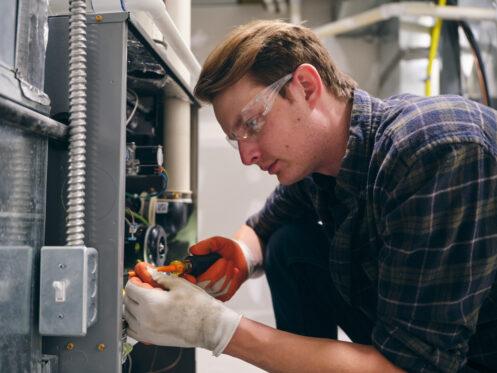The idea of a professional furnace installation may create stress as you think about the installation time. While you can never pinpoint the exact time an installation will take, experienced HVAC technicians have enough experience to get through the process smoothly. Before your furnace installation takes place, learn about the whole process so you will understand which step your technician is on and what to expect as the project nears completion.
Old Furnace Removal
Unless your home is a new construction, a majority of furnace installation projects will typically begin with the removal of the old furnace. Depending on the location, a technician can remove the furnace as one whole piece or may need to break the furnace down into multiple pieces. Ideally, you want to have the best exit methods ready for furnace removal.
If you have a bulkhead entry in your basement, then you will want to clear a path to the bulkhead area for the fastest removal of the old furnace. You can help speed up the process by keeping the bulkhead unlocked. If the weather permits, then you can also keep the bulkhead wide open. This will offer the quickest way for workers to lift and remove the furnace from the basement area.
As part of the removal process, a technician will check all the connection points to the furnace. This includes water pipes, oil pipes, or air ducts. Different HVAC systems will rely on different connection points, so each one will need a visual inspection.
Once completely out of the home, the technicians will clean and prepare the area for the new furnace installation. This includes the removal of any debris or parts that could create interference for the new installation.
Preparation and Electrical Shut Off
In preparation for the new furnace installation, HVAC technicians may need to shut off some resources in the house. This could include water pipes or electrical connections. In many cases, only the power fuse dedicated to the furnace will need to get shut off, but there may be periods when the whole power to the house is shut off. When connecting new furnaces, multiple power outlets may be connected. If the power to your house is running, you do not want a power surge to create any issues.
The time that the power is off will vary but should not take any longer than a few hours. To help prepare, you should charge wireless devices, keep your refrigerator closed, and refrain from other tasks like cooking. When you get your furnace installation appointment time, you can prepare a day ahead so that you don’t run into any conflicts or issues. A technician will tell you when the power is fully turned back on so you can use appliances, electronics, or other powered items.
Furnace Location and Piecing Together Parts
Once the area is cleared out and ready to go, a technician will proceed with the new furnace installation. New furnaces are typically packaged in a box, and technicians will often take the whole box right to the installation location for easy unpacking. If your basement or crawl space entryway is too small, then they may unpack the furnace in pieces and carry those elements down to the area. In cases like this, you can expect a little extra time added to the installation.
A technician will organize the furnace and follow the installation instructions supplied by the manufacturer. For example, for condensed product packaging, some furnaces will include pieces packed into hollow parts of the furnace. A technician will follow the instructions to properly unpack and piece those elements together.
After putting the furnace together, a technician will follow the proper protocol for electrical connections. In some cases, they will have the electrical training. In other cases, an electrician may be needed if there are fuse issues or the home’s electric grid becomes too overloaded due to the new furnace’s power. In those situations, you may run into slight delays as they wait for the electrician to arrive. In other situations, a staffed electrician will time their visit to complete tasks and move ahead with the next steps of the process. Either way, delays are typically minimal and will help ensure proper operations of the furnace in the long run.
Piping Needs
A key element of any furnace installation is proper piping. The piping connections to a furnace will depend on the type of furnace and heating in the home. For example, an oil-burning furnace with baseboard heaters will need water pipe connections that loop through the furnace. A gas-powered furnace will likely use air ducts to push hot air through the home and supply each room with a connection.
For every furnace installation, the pipe connections are just as important as the furnace itself. A technician will consider multiple aspects when connecting sheet metal ducts. The first consideration is the layout. They want to supply you with the most efficient way to deliver heat through the home without the need to have a maze of air ducts going through your basement. Based on the furnace layout, they will connect ducts to save space and look clean across the basement area.
If your current duct system is old and not compatible with the new furnace, then you can expect additional time to cut sheet metal and properly map out a new duct system that delivers hot air through the home. Along with proper duct mapping, a technician needs to ensure the seals are tight with all the connections. Any type of leak can cause a major loss of heating efficiency and could create problems with the new furnace as well. For example, a water pipe leak could land directly on a furnace and create issues.
Testing Process
After the pipe connections, an HVAC technician will prepare a full test run of the furnace. At the furnace itself, a technician will ensure the furnace starts up correctly and runs. This includes indicator lights, intake valves, and proper temperatures.
In the rest of the home, a technician will check to ensure thermostats work properly. They may wait for a full cycle to ensure rooms reach a proper temperature. During this time, they will likely clean up any supplies or debris that was left around.
Once tested, a technician will help you connect any smart apps to the new furnace. A smart app provides options like scheduled heating times or specific zoning for rooms. Doing this right away can help you avoid any issues in the future or the need to contact technicians for a new appointment. In some cases, the furnace will have its own app. In other cases, you can implement the new furnace smart connections with any current smart home apps you have.
Schedule Your Furnace Installation Today
While it’s challenging to predict the exact duration of a furnace installation due to factors like the condition of existing ductwork and the specific model of the new furnace, having a thorough understanding of the process can significantly ease any concerns. Knowing what to expect at each stage from old furnace removal to the final test run allows for better planning and a smoother experience. Remember, experienced technicians work efficiently to minimize disruption and ensure your home is heated comfortably.
If you need any type of furnace installation in Garland, Dallas, or the surrounding area, our team at On Time Experts is ready to provide expert services. We offer a full range of heating services and can schedule and plan a new furnace installation that fits your schedule. Our team is also available for cooling, plumbing, and air quality solutions. Contact us today to schedule your appointment.

